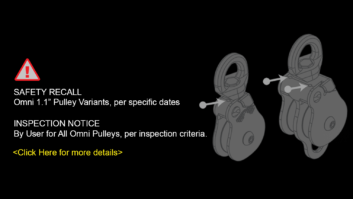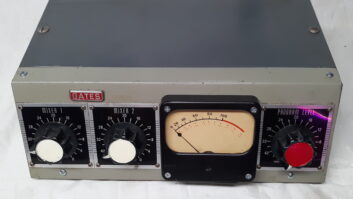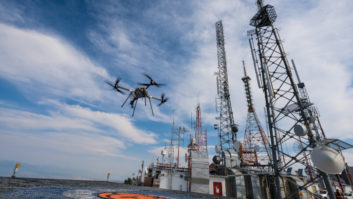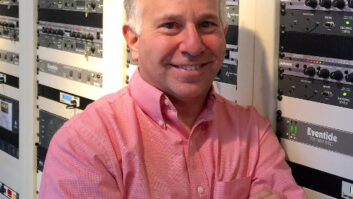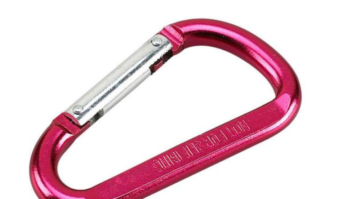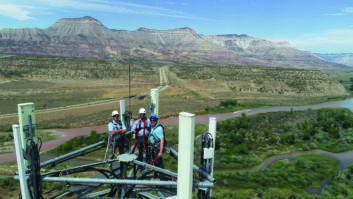Tower inspection and climbing
Jul 1, 2006 12:00 PM, By John Battison, P.E., technical editor, RF
It appears to me that tower climbing devotees and station engineers who do such things are people who delight in looking down on the world. I think such activities were more prevalent many years ago than they are today. In those happier, pre-OSHA, pre-EPA days there were more engineers who delighted in finding out how tower systems work and examining them from a bird’s eye point of view. Today there seems to be less interest in doing things than in operating them. This is possibly because equipment is more reliable now. Also, there is a trend toward black boxes that are returned to the manufacturer rather than being opened and repaired at the station.
It was not at all unusual to visit a station and find one of the operating engineers halfway up a tower changing a light bulb or merely enjoying the view. I rarely saw anyone using a safety harness, nor were there many nice, convenient one-man elevators. In those days it was also not unusual to recognize an old-timer by the number of RF burns on his hands. Nowadays we switch off all the transmitters feeding into the tower, or reduce power to a safe power level before approaching a nonionizing radiating device.
Management has learned to forbid station personnel from performing dangerous feats such as tower climbing because of insurance and worker’s compensation issues. This is, in fact, a wise proscription for station managers to include in station operating rules and job descriptions.

A qualified tower climber relies on his experience as much as his equipment.
Experience counts
If a station employs an experienced and capable engineer who is also an experienced climber with a serviceable, approved safety harness, the temptation to use this person’s abilities can be extremely strong, especially for such simple things as changing a beacon or side obstruction bulb. At the same time this knowledgeable person can inspect the tower and look for developing problems, especially if additional antennas are mounted on the tower. In this way, the manager gets a much bigger bang for his buck than paying a qualified tower climber to merely change the lamps. But the decision to invoke all these engineering extras must be based on such matters as insurance coverage liability and ability of the climber.
Whenever an experienced tower climber, who is also a good RF engineer, becomes available take advantage of his expertise. That is provided he has suitable, safe and approved tower climbing equipment and the insurance policy covers such activities.
It is unfortunate that the last link in the chain between the microphone and the listener is the station’s antenna system. Almost invariably no one looks at antenna systems until something goes wrong, or monitors say something is wrong, and something really is wrong. The wise engineer/manager should take every opportunity to examine the last link in the chain whenever an opportunity arises.
A good combination tower climber/engineer can start by examining the base insulator for cracks, or RF discharge tracks across it or failed copper strapping between the tower base and ground. The copper tubing connections between the doghouse insulator and the tower base with its tower lighting power line inside is a frequent source of trouble. Ideally RF leads should be well braised to a tower leg and nut and bolt connections should be examined with a critical eye.
If the tower is lit at night, the ac power cable passing through the center of the RF loop should be examined for damage and potential unwanted connections. Grounding connections to conduit going up the tower should be carefully checked. This is especially important when folded unipole radiators seem to be proliferating and an ungrounded neutral can cause all kinds of trouble producing unexpected impedance changes.
Resist temptation
Apart from tower maintenance and emergency work, tower inspections are probably the main reason for engineers to climb a tower. Tower inspections will not be worth much if they are not made by someone who knows what he’s doing and what he is looking for. Bell Tower offers an excellent free handbook on tower inspection and towers in general. It can be downloaded at www.belltowercorp.com.
Vertical radiators generally arrive in specified lengths for assembly at the transmitter site and are bolted together. These joints in the tower can become a source of trouble if rust gets in or couplings and bolts loosen. Skin effect must always be taken into account when handling RF and the higher the frequency the greater the effect. Anyone climbing a tower must be sure to examine tower section continuity.
Similar conditions apply to drop, or skirt, wires on folded unipole antennas. At the point on the tower where the supporting arms and tuning short connection are located the tower must be absolutely free of paint or rust. The wire from the skirt should ideally be welded to the tower, but in fact it is usually bolted. This can be a cause of noise or impedance problems, as can the other end of the connection that taps onto the skirt by means of a wire connector. Shaking the tower or the skirt assembly can indicate a dirty connection.
Specify that all section-to-section joints have a welded continuity strap or something similar across the butt ends of the adjoining sections. If this is done, and maintained by inspection, as time passes one troublesome problem source will be eliminated.
With the increasing use of fiber cables for tower guys as insulators or for full tower guying there is a decrease in guy greasing activity. It’s been a long time since I’ve heard anyone talk about needing to grease guy wires. It was always a spectacle to see a man sliding down a guy in a sort of bosun’s chair contraption.
Guys and guy cable fittings are often ignored until a tower falls or begins to lean or guys flap in a strong wind. Regular checking with a tensionometer is advisable regardless of tower size. Surprising slackness can often be encountered without much warning.
It pays to be sure that the guy anchors really are anchors, and not just dead weights on the bottom of a guy. Metal anchors and concrete footings have a bad habit of rusting or crumbling or a combination of rust and chemical/electrolytic action that doesn’t always show on the upper surfaces. In soil that has a heavy chemical content use sacrificial anodes to protect guy anchors.
E-mail Battison at[email protected].





